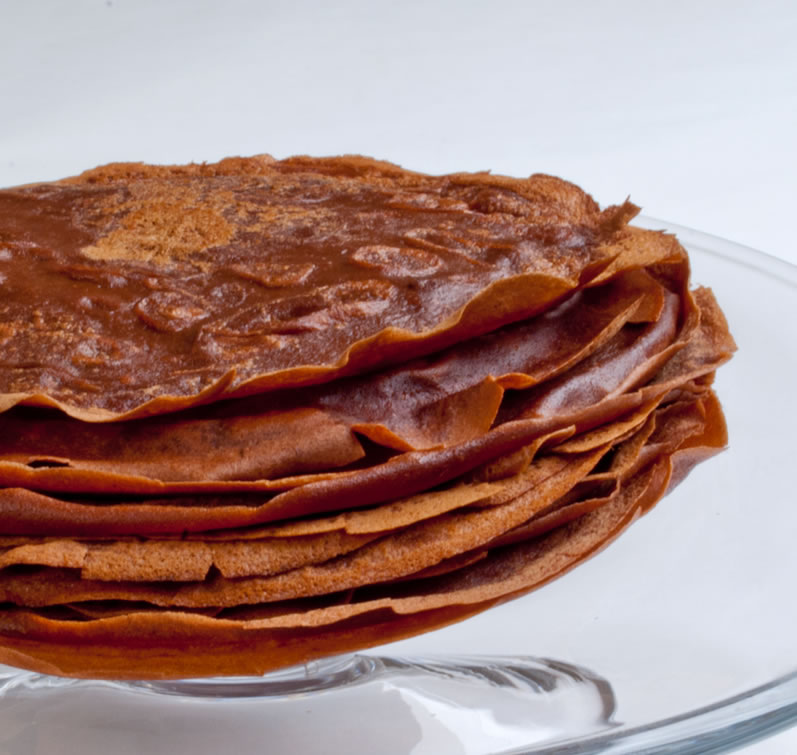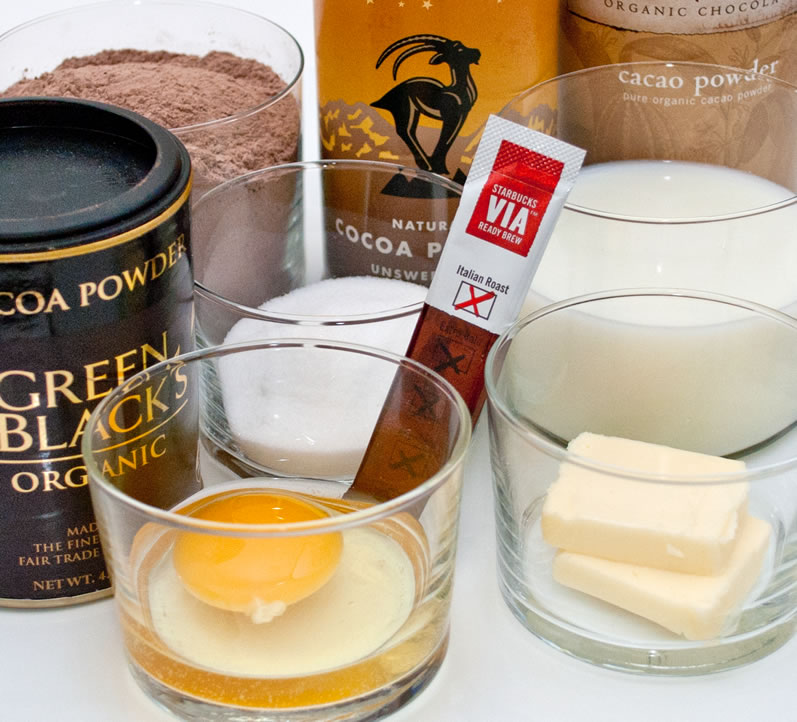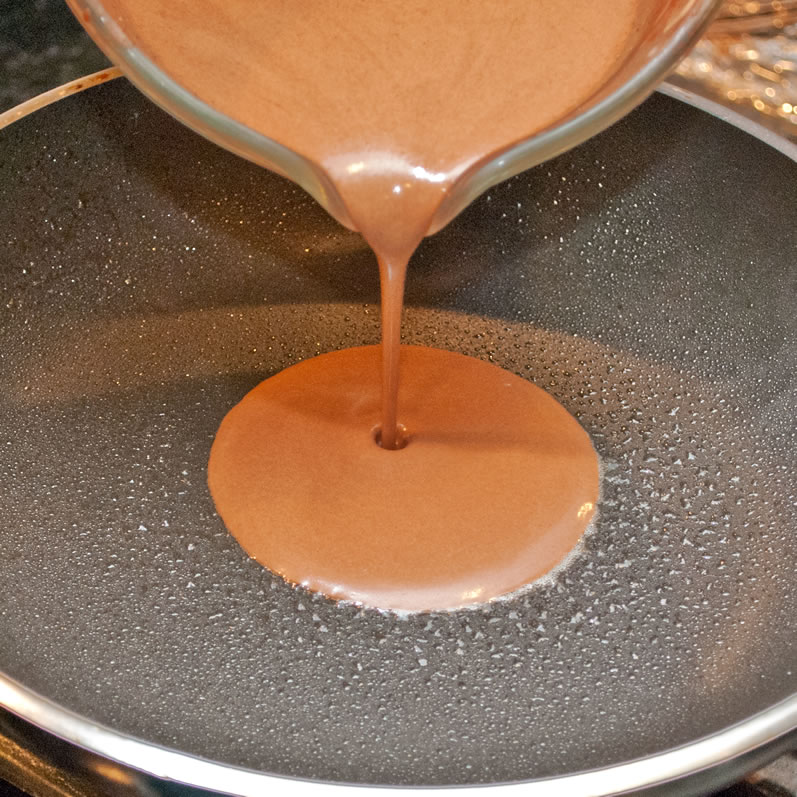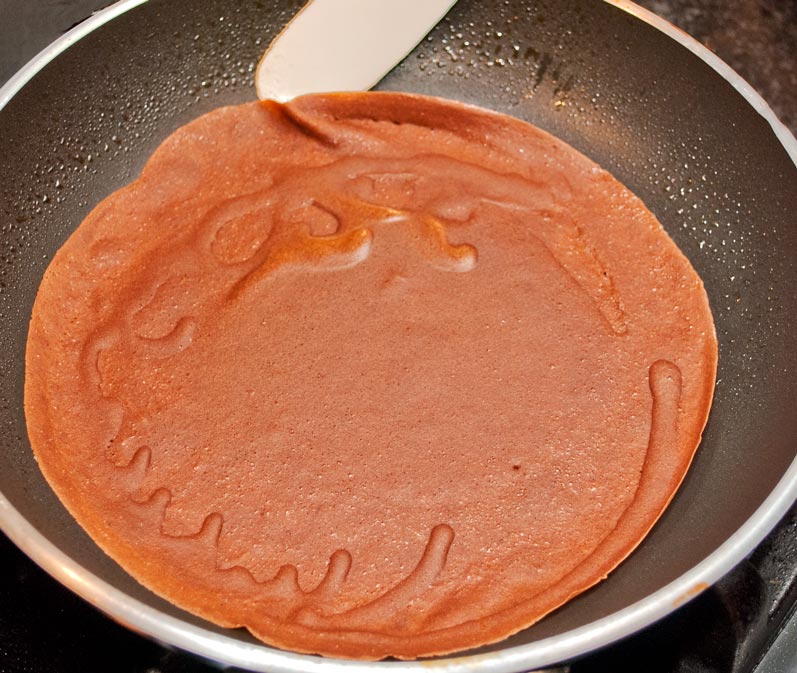This is post #2 of LunaCafe’s annual Love Rules! All Chocolate! All Month! celebration. For the next several weeks, I will post nothing but very special chocolate recipes, each one perfect for sharing with those special people in your life. Click the link above for photos and pointers to all past chocolate posts. And don’t miss the post titled, The Wonderful World of Unsweetened Cocoa Powder, which details 17 fabulous cocoas, including my picks for top honors. Now back to the celebration!
Recipes can be inspiring, but there is nothing as satisfying as truly understanding the underlying formula and technique of a particular dish. Once you’ve got those under your belt, you OWN that dish and can riff it successfully and endlessly. That’s when the real fun begins.
Take the concept of dessert crepes (pronounced krep in French or krape in English) for instance, which are a type of very thin pancake. You can go straight to a comprehensive French cookbook, grab the basic dessert crepe recipe and process, and rely on that forever. Or, if you are more curious, you can gather 10-20 solid resources, compare the formulas and processes, and then hit the kitchen and test your way through them. When you are done, the entire world of desert crepes will open up for you and reveal its secrets. You will become the Zen master of dessert crepes.
That’s what I like to do, especially when it comes to concepts that are useful building blocks to a wide variety of dishes. I developed this methodology when I owned the Northwest Culinary Academy. Students didn’t come to learn recipes. They wanted to understand the ingredients, principles, and processes that underscored every dish presented. I still work this way today and there is no end to the learning.
A few Things to Understand about Crepe Ingredients
For crepes, the liquid is always the final variable. You must add enough to create a batter with the viscosity of heavy cream—not too much thinner and definitely no thicker. Formulas with a high egg proportion will accommodate and even require more liquid, regardless of what the recipe specifies. Thus, you can actually disregard the liquid amount specified in the recipe and add just enough liquid to achieve the correct pouring consistency.
The sugar amount is completely variable, regardless of the formula. However, the more sugar you use, the more difficult the crepes will be to handle.
Crepes made with a low egg formula produce thin, very light crepes. However, this formula makes the crepes more difficult to handle without tearing. If you are new to crepe making, it’s probably best to use a medium egg formula.
The Big Secret to the Lightest Crepes Possible
There is one amazing secret to producing the lightest crepes possible. Are you ready? Okay, here goes: Use half water for the liquid. Actually, Julia Child mentioned this in Mastering the Art of French Cooking long ago, but I haven’t seen it discussed elsewhere since then. When I was developing dessert recipes for Cooking Light Magazine, I used this bit of esoteric knowledge to craft crepes that were delicious, ethereally light, AND low in calories. My low to medium egg, low butter formula is now my standard crepe batter. That’s how much I like it.
Comparing 8 Dessert Crepe Formulas
The following formulas are based on a constant of 1 cup of unbleached, all-purpose flour. Formulas were extrapolated from cookbooks of respected culinary authorities (listed below).
Experiment with the formulas over time to determine which ones ring your bell the most. Do you like your crepes rich, dense, and tender? Then go for a higher egg and higher fat formula. Or do you like your crepes crackling thin, ethereally light, and on the lean side? Then go for a lower egg and lower fat formula. Regardless though, each of these formulas produces heavenly crepes, so no worries about choosing a clunker.
Super High Egg, Super High Butter Formula (Francois Payard)
4 eggs
5 tablespoons unsalted butter
3 cups liquid (milk)
2-3 tablespoons unsweetened cocoa (alkalized)
¼ cup sugar
High Egg, High Butter Formula (Joseluis Flores)
2 large eggs + 2 large egg yolks (equivalent to 3 large eggs)
4 tablespoons unsalted butter
1 cup liquid (milk)
3½ tablespoons cocoa (unspecified)
1 tablespoon + 2 teaspoons sugar
High Egg, Medium Oil Formula (Alice Medrich)
3 large eggs
3 tablespoons vegetable oil
1¾ cup liquid (milk + water)
¼ cup cocoa (natural)
No sugar
High Egg, Low Butter Formula (John Scharffenberger)
3 large eggs
1 tablespoon unsalted butter
3 cups liquid (milk)
No cocoa
1 tablespoon sugar
Medium Egg, Low Butter Formula (Susan S. Bradley)
2 large eggs or 4 egg yolks
2 tablespoons unsalted butter
1¾ cups liquid (milk + water/coffee/juice/liqueur)
¼ cup cocoa (natural or alkalized)
¼ cup sugar
Medium Egg, Medium Butter Formula (Susan S. Bradley)
2 large eggs
3 tablespoons unsalted butter
1¾ cups liquid (milk + water/coffee/juice/liqueur)
¼ cup cocoa (natural or alkalized)
¼ cup sugar
Low Egg, Medium Butter Formula (Julia Child)
2 large egg yolks (equivalent to 1 large egg)
3 tablespoons + 1 teaspoon unsalted butter
1½ cups + 2 tablespoons liquid (milk + water + liqueur)
No cocoa
2 teaspoons sugar
Low Egg, Low Butter Formula (Susan S. Bradley)
1 large egg or 2 egg yolks
2 tablespoons unsalted butter
1½ cups liquid (milk + water/coffee/juice/liqueur)
¼ cup cocoa (natural or alkalized)
¼ cup sugar
The Lightest Chocolate Crepes (with Spirited Mocha Crepes Variation)
Due to the sugar in the batter, dessert crepes are more fragile and difficult to handle without breaking than entrée crepes. You will likely ruin the first few crepes, but that’s par for the course, so no worries. They will still be imminently edible, and since they may be torn, rumpled, or otherwise marred, they are also just perfect for you to eat on the spot. You may want to purposely ruin a couple more after you’ve tasted these. They are fabulous right out of the pan with nothing more than a dusting of powdered sugar.
NOTE This batter requires two hours of refrigeration before it is ready to use. To save time, use Wondra brand instant flour in place of the all-purpose flour (in the same proportion) and proceed right away with cooking the crepes. There will be no difference in the quality of the crepes.
NOTE You can use either natural or alkalized unsweetened cocoa here. The most noticeable difference is in the color of the crepes. Alkalized cocoa produces a very dark- brown crepe, whereas natural cocoa produces a rich, slightly reddish-brown crepe.
NOTE For the Spirited Mocha Crepes variation, use coffee instead of water, cinnamon, and Kahlua liqueur if desired.
1 cup King Arthur unbleached, all-purpose flour (4½ ounces)
¼ cup unsweetened cocoa (natural or alkalized process)
¼ cup sugar
½ teaspoon cinnamon, optional
½ teaspoon fine sea salt
1 cup cold milk
½ cup plus 2 tablespoons water or freshly brewed strong coffee (if desired, replace 2 tablespoons water or coffee with liqueur of choice as suggested below)
2 large eggs or 4 large egg yolks
2 tablespoons unsalted butter, melted
2 tablespoons Kahlua, Frangelico, Grand Marnier, brandy, dark rum, or liqueur of choice, to replace 2 tablespoons water, optional
vegetable spray
- In a mixing bowl, sift the flour and cocoa, and then whisk to incorporate. Add the sugar, cinnamon, and salt, and combine.
- Add the milk, water, egg, and melted butter. Whisk until smooth. Add liqueur if using.
- Cover and refrigerate for at least 2 hours to fully hydrate the flour. Put the batter into a large glass measuring cup with a pouring spout.
- The batter should be the same consistency as very light cream, just thick enough to coat a wooden spoon. If, after making your first crepe, it seems too heavy, beat in a tablespoon or two of additional water and try again. The cooked crepe should be about 1/16-inch thick.
- To cook the crepes, spray a well-seasoned or nonstick 6-7 inch bottom-diameter omelet or crepe pan with vegetable spray. Set over moderately high heat until the pan is just beginning to smoke. Immediately lift the pan from the heat with one hand and pour 2-3 tablespoons of batter into the middle of the pan with the other hand. Quickly tilt the pan in all directions to run the batter over the bottom of the pan in a thin film. Pour any batter that does not adhere to the pan back into your bowl; judge the amount for your next crepe accordingly. This whole operation takes just 2-3 seconds.
- Return the pan to the heat for 60-80 seconds. Lift the edges with a thin, flexible spatula and check to see if the underside is set. If so, the crepe is ready for turning. Turn the crepe by deeply grasping the edge nearest you with both of your thumbs and forefingers and quickly flip over. (If you can’t do this without burning yourself, put on disposable gloves for the procedure. They provide just enough protection from the heat to make the flip comfortable for your fingers.) Brown for a few seconds. This second side is rarely more than a spotty brown and is usually used as the underside of the crepe.
- Repeat with the rest of the batter, stacking the crepes on a plate as you continue.
- To frig or freeze your crepes, separate them with sheets of waxed paper or foil, wrap well in plastic wrap, and seal in a freezer bag.
Makes about 2¼ cup batter; Makes 12-14, 6-7 inch diameter crepes.
Recipes
- B Comme Bon: Pancakes KKO
- Chocolate Crepes on TasteSpotting
- Delightful Delicacies: Dark Chocolate Crepes
- SkinnyTaste: Chocolate Crepes with Strawberries
- The Domestic Goddess: Chocolate Crepes
- Google Images: Plating Crepes
- Emeril Lagasse’s Chocolate Crepes with Fresh Strawberries
- Sea Salt with Food: Chocolate Crepes
Cookbooks
- Bittersweet: Recipes and Tales from a Life in Chocolate by Alice Medrich
- Chocolate Desserts by Pierre Herme by Dorie Greenspan
- Chocolate Epiphany by Francois Payard
- Cocolat: Extraordinary Chocolate Desserts by Alice Medrich
- Dulce by Joseluis Flores
- Essence of Chocolate by Robert Steinberg
- Mastering the Art of French Cooking, Volume 1 by Julia Child
- Pure Dessert by Alice Medrich
- The Essence of Chocolate by John Scharffenberger and Robert Steinberg
Crepe Pans & Tools
- Crepe Making Tools
- Cucina Pro 1447 Cordless Crepe Maker
- World Cuisine 9.5-Inch Crepe Pan
There’s More
Check out these additional CHOCOLATE recipes, which are from the first, second, and third (thus far) Love Rules! All Chocolate! All Month! celebrations at LunaCafe:
Season 3
Season 2
- Bittersweet Chocolate Orange French Toast for Lovers
- Fried Banana Split with Mexican Chocolate Sauce & Strawberry Lime Salsa
- LunaCafe Otherworldly Silky Fudgy Brownies
- Quintessential Bittersweet Chocolate Sauce
- The Wonderful World of Unsweetened Cocoa Powder
- White Chocolate, Cardamom & Coconut Beignet
Season 1
- Bittersweet Chocolate & Cabernet Butter Cake
- Bittersweet Chocolate & Montmorency Cherry Morning Love Muffins
- Bittersweet Chocolate & Toasted Walnut Cookies Perfecta Mundo!
- Burnt Sugar & Rosemary Chocolate Tarts
- LunaCafe’s Ultimate Chocolate Pudding
- Luscious White Chocolate & Raspberry Rose Petal Cheesecake
- Mexican Hearts of Fire Cookies
Copyright 2011 Susan S. Bradley. All rights reserved.






Very nice crepes! I have never made crepes but I love to eat them.
Love chocolate crepes, and for some reason I missed your post. OMG! Fabulous..
Absolutely delicious! Chocolate crepes with a light vanilla sauce or cream are awesome.
Thank you!
We’ve made crepes many times, but never made chocolate ones. Your photos are beyond fabulous.
Sam
These look divine!
I’m definitely making these for Valentine’s Day.
You use King Arthur’s Flour in most of your recipes so I wanted to know what makes it so special? I’ve never heard of it and it’s not offered in my area, so I wondered if there is something comparable or will any unbleached flour give the same results?
Thanks.
Ann, after several years of working to perfect the LunaCafe Otherworldly Cookies line (hopefully to launch in the near future), I discovered that flour should be treated as a distinct ingredient in baking. Results will vary from one flour to the next and even from bag to bag of the same flour for many brands of flour. I achieved the most consistent, most excellent results from bag to bag with King Arthur flour, so that’s what I use for all baking now. If you can’t get it, then use another high-quality brand of unbleached, all-purpose flour. Perhaps a local brand with high standards of consistency. Hope this helps…Susan